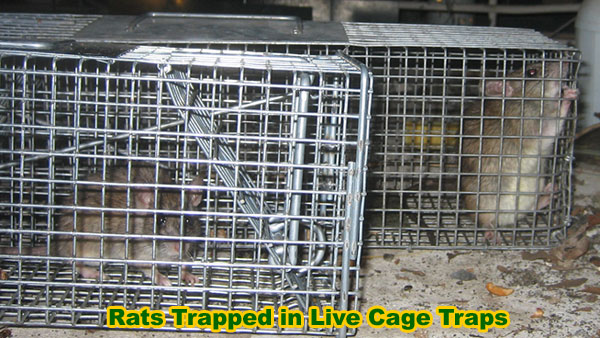Barns are very challenging, because by nature they don't qualify for the one and only way to keep rats out for good - sealing all entry points shut that lead into the structure. It's usually
impossible to seal a barn shut. Just too big, to many openings, big open barn doors, etc. And repellents are worthless. So your only hope is a program of trapping. I recommend lockable
boxes with snap traps inside. You could try poison, but man, poison is just such a horrible thing to do.

Cage traps tend to work well in barns, because animals might step on snap traps.
How to kill rats in a barn
The most important thing anyone is going to tell you about how to kill rats in a barn is that poison is not an option. Do not buy into the claims on the label. Most poisons are inhumane and ineffective. The thought of poison appeals to many homeowners because they think it means less of a cleanup process. A poisoned rat will disappear, never to be seen again. This is almost a correct assumption. A poisoned rat will indeed disappear, but chance are you will be forced to see it again when the smell of decay invades your home. Poisoned animals have the tendency to sneak into walls and floors where they are hard to reach. The animal will then die in this location. If you want to get rid of the resulting smell, you will have to locate the body and have it removed. By the time most homeowners get to the carcass, it has become far more of a cleanup project than they ever imagined. If you want to effectively kill rats at home, you will need to purchase snap traps. Snap traps are the most reliable traps on the market and are used by many professionals.
You can even set them on the barn roof.

Scents that drive rats rodents away from a barn -
There is no silver bullet when it comes to keeping rats and other rodents away from your barn. Someone, somewhere, will tell you that mothballs are the bee’s knees and the best rodent repellent you can buy. This is incorrect. When you think about rats and where they live and what they eat, you will begin to understand how absurd it is to think that mothballs would keep them away. A rat that lives in the sewer is exposed to all sorts of toxic, hazardous gases. Humans that enter sewers must wear masks. Rats remain unaffected. Even if a rat disliked the faint odor of mothballs, it would never leave a place it has established as safe. To venture outside would mean death by predation or starvation. Other scent-based repellents include peppermint oil, sulphur products and predator urine. It has been documented that rats will live under dog houses and steal the dog’s food when it is not looking. These animals are bold and intelligent. There is no odor that will keep rats away from your home. If you want to keep rats away you need to keep your home in state of good repair, making sure any and all holes are sealed tight.
Do You Need Help? I wrote this website to provide information on How to Get Rid of Rats in the Barn in the case that you have
a rat problem and need to make an informed decision about what to do. If you
have any questions you may email me, but I do know from experience
that rat removal is not simple. If you need professional help solving your
wildlife conflict, I recommend that you talk to a professional rat
control expert in your town by clicking on my
National Wildlife Control
directory, which lists experts who I recommend in every USA city and town who can
help you with your rat issue in the Barn.
More Rat Articles I've Written:
How to Get Rid of Dead Rats
How to Kill Rats
Rat Repellent
How to Get Rid of Rats in Your House
How to Get Rid of Rats in Your Walls
How to Get Rid of Rats in Your Kitchen
How to Get Rid of Rats in Your Garage
How to Get Rid of Rats in Your Attic
How to Get Rid of Rats in a Barn
How to Get Rid of Rats in Your Basement
How to Get Rid of Rats in the Ceiling
How to Get Rid of Rats in Your Garden
How to Get Rid of Rats in the Insulation
How to Get Rid of Rats in the Crawlspace
How to Get Rid of Rats in Your Yard
How to Get Rid of Rats in a Restaurant